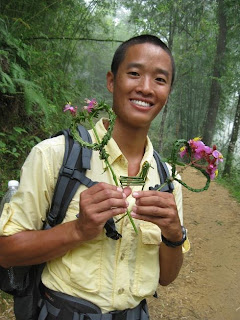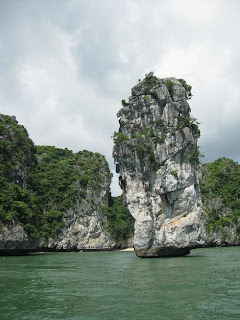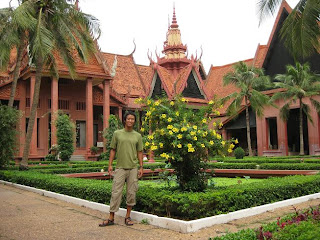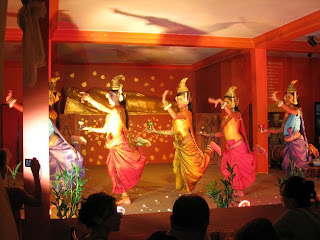to the Chinese border and is surrounded by villages of minority people who
fled China in the 19th century. Each minority has its own culture, language,
and unique and colorful clothing style. Their main source of livelihood is
rice farming and the mountain slopes surrounding Sa Pa have been carved into
vibrant rice terraces. Unfortunately, today Sa Pa is over-touristed and
many visitors are not respectful of the people or their culture. This has
caused many of the locals to stay away from outsiders and their flashing
cameras. Other locals, however, have capitalized on the tourist economy and
flood the town daily to sell their handicrafts. Many children also sell handicrafts because the Vietnamese government does not provide them with school supplies...even though they are officially a communist country!


The beautiful Sa Pa scenery
We spent our first morning in Sa Pa visiting the village of Cat Cat, home to
the Black H'mong minority group. The hilly, three-mile trek through the
village rewarded us with views of lime-green rice terraces,
adorable children playing in the river, and a foaming waterfall. We enjoyed
a lunch of barbecued pork, rice grilled inside a bamboo stem, and a taste of
the local apple wine. In the afternoon we walked through a park up to a
vista point, where we had great a great view of the town below us.

Sticky rice and veggies wrapped in pork: A delicious meal!
To see the other villages, we signed up for a guided trek, overnighting in
a homestay. We were very disappointing with the tour agency that we signed
up with because they gave us a lot of false information about the trek. They
told us that we would be visiting six villages, that we would have a minority guide, and that all meals would be included. Instead, we only visited three villages, we had a guide who had grown up in Hanoi, and they did not provide us with lunch on the second day (even though the trip was scheduled to end at three pm). But all that aside, we still had a good time. This was mainly due to the fact that another group joined us at our homestay. All they people in the other group were really friendly and fun to talk to, and they had a super sweet and amiable minority guide named Ling.
The first day we hiked through a H'mong village and stopped there for lunch. The hike was beautiful, with great views similar to those we had seen the day before. As we were hiking we accrued a small following of H'mong women who were going back to their village. They made conversation with us with the little English they knew and presented us with little gifts of bamboo origami that they had deftly created as they were walking. Their company was enjoyable, but we knew that they were buttering us up in hopes that we would later buy their handicrafts.

Some villagers made Leslie and me hearts out of ferns
After lunch we hiked to a Dao village, where we would stay overnight. Our hosts were nice, but knew very little English so we couldn't really talk to them. We spent the rest of the afternoon exploring their farm (they had rice paddies, fruit trees, and some cute fat pigs) and chatting with our group mates and Ling.
In the evening we had a delicious, home-cooked meal - a definite highlight of the trip. The family had cooked four or five different stir fires with interesting veggies, and there was plenty of food to go around. After dinner I helped with the dishes and took the opportunity to get to know Ling a little better. She was completely conversational in English, even though she had never had any formal schooling. In fact, her English was even better than our guide's, who had a university degree in the language! All the English that Ling knew, she had picked up over the past two years just from talking to tourists.

Ling was one of the nicest and knowledgeable guides we met
The next day we hiked through a bamboo forest to the top of a waterfall. It had rained the night before so the the path was really muddy and slippery. But this just added to the fun and adventure of it all. After the waterfall, we had to split off from Ling and her group. We continued on for another couple of kilometers, hung out by the river for a bit, and hiked up the road to get a ride back to town. We spent the rest of the afternoon exploring the markets in Sa Pa, where we had the chance to see many different minority people in their colorful outfits.

Girl from Black H'mong minority hilltribe

Zai minority hilltribe women at the market

Dzao minority hilltribe woman. We bought some postcards from her.














































